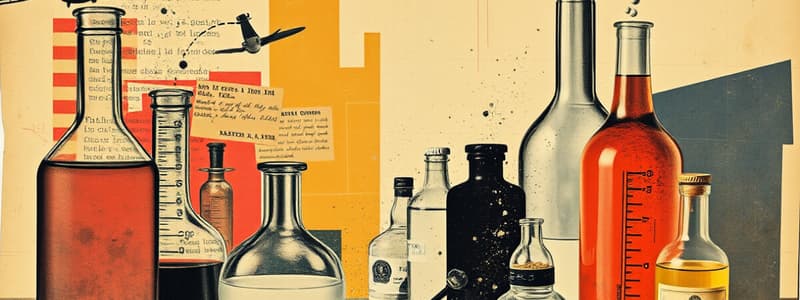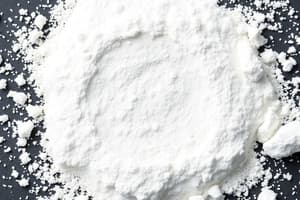Podcast
Questions and Answers
What is matter?
What is matter?
That which occupies space and mass; a physical substance
What is an atom?
What is an atom?
An extremely small part, quantity, or amount
What is a pure substance?
What is a pure substance?
A sample of matter with both definite and constant composition with distinct chemical properties
What is an element?
What is an element?
What are compounds or molecules?
What are compounds or molecules?
What is a mixture?
What is a mixture?
What does homogeneous mean?
What does homogeneous mean?
What is a solution?
What is a solution?
What does heterogeneous mean?
What does heterogeneous mean?
Which of the following are pure substances? (Select all that apply)
Which of the following are pure substances? (Select all that apply)
Which of the following is NOT a pure substance?
Which of the following is NOT a pure substance?
A substance that is made up of only one kind of atom is a(n)...
A substance that is made up of only one kind of atom is a(n)...
If an unknown substance CANNOT be broken down into simpler substances, it is....
If an unknown substance CANNOT be broken down into simpler substances, it is....
What is the symbol for aluminum?
What is the symbol for aluminum?
The symbol for gold is...
The symbol for gold is...
If a material contains two or more elements joined in a fixed proportion it is a(n)...
If a material contains two or more elements joined in a fixed proportion it is a(n)...
Water is a compound because it...
Water is a compound because it...
Which of the following is a mixture?
Which of the following is a mixture?
Which of the following is a characteristic of a mixture?
Which of the following is a characteristic of a mixture?
A mixture that appears to contain only one substance is a(n)...
A mixture that appears to contain only one substance is a(n)...
Which of the following is a heterogeneous mixture?
Which of the following is a heterogeneous mixture?
A mixture can be classified as a solution, suspension, or colloid based on the...
A mixture can be classified as a solution, suspension, or colloid based on the...
You are about to open a container of soy milk but notice that there are instructions to 'shake well before serving.' The soy milk is most likely a...
You are about to open a container of soy milk but notice that there are instructions to 'shake well before serving.' The soy milk is most likely a...
Matter that always has exactly the same composition is classified as a pure substance.
Matter that always has exactly the same composition is classified as a pure substance.
Pure substances are either colloids or heterogeneous.
Pure substances are either colloids or heterogeneous.
An element has a fixed composition because it contains only one type of atom.
An element has a fixed composition because it contains only one type of atom.
A compound can be made from two or more elements or other compounds joined together in a fixed composition.
A compound can be made from two or more elements or other compounds joined together in a fixed composition.
The substances in a heterogeneous mixture are evenly distributed throughout the mixture.
The substances in a heterogeneous mixture are evenly distributed throughout the mixture.
In a heterogeneous mixture, parts of the mixture are noticeably different from one another.
In a heterogeneous mixture, parts of the mixture are noticeably different from one another.
Flashcards are hidden until you start studying
Study Notes
Classifying Matter
- Matter: Physical substance that occupies space and has mass.
- Atom: The smallest unit of matter; extremely small part or quantity.
- Pure Substance: Consistent and definite composition with unique chemical properties.
- Element: Fundamental substance consisting of only one type of atom.
- Compound/Molecule: Formed when two or more atoms bond together; represents a single substance.
- Mixture: Combination of two or more substances where each retains its own properties.
- Homogeneous Mixture: Uniform composition throughout; all components are the same kind.
- Solution: A specific type of homogeneous mixture consisting of a solute dissolved in a solvent.
- Heterogeneous Mixture: Non-uniform mixture with visibly different substances or phases.
- Characteristics of Pure Substances: Contains only one type of atom or molecule; has a fixed composition.
True or False Statements
- Pure substances maintain a consistent composition; they can be elements or compounds.
- An element is defined by its fixed composition of a single type of atom.
- A compound consists of multiple elements combined in fixed proportions.
- Heterogeneous mixtures display variations with distinct components that are not evenly distributed.
Application of Concepts
- A substance made of only one kind of atom is classified as an element.
- If a substance cannot be broken down further, it is categorized as an element.
- Chemical symbols for elements follow specific conventions (e.g., Aluminum is represented as Al, Gold is Au).
- Mixtures can be differentiated: for example, sand is a heterogeneous mixture, while sugar water is homogeneous.
- Suspensions involve larger particles that may settle, prompting the need for mixing (e.g., soy milk).
Classification Criteria
- Mixtures are classified based on particle size: solutions, colloids, and suspensions.
- Heterogeneous mixtures display components that are distinctly visible, while homogeneous mixtures appear uniform.
Key Definitions
- Colloid: A mixture where one substance is dispersed throughout another but does not settle out.
- Solution: Specifically a homogeneous mixture where solute particles are not visible.
Studying That Suits You
Use AI to generate personalized quizzes and flashcards to suit your learning preferences.




